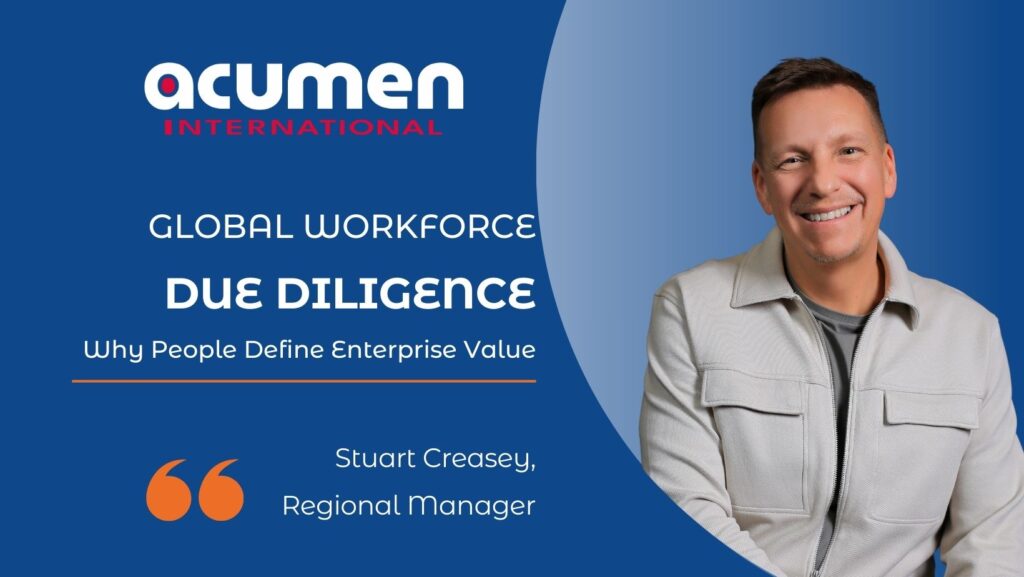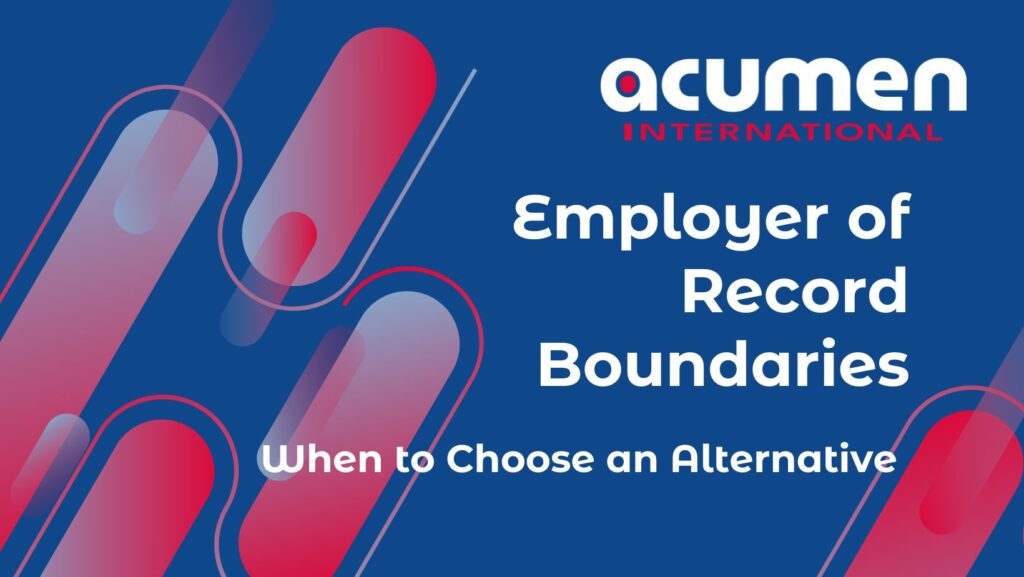Welcome to the October 2025 edition of Acumen International’s Global Employment Tax & Compliance Newsletter.
This month marked a shift from new regulation to active enforcement. Authorities in the EU and elsewhere have begun operating large digital systems that now govern border crossings and employment data in real time.
At the same time, governments are moving to recover administrative costs and expand data-matching across tax, labour, and immigration databases. The theme of the month is clear: the discussion phase is over, and the systems are now working.
For employers, this is the point where compliance becomes operational. Payroll, HR, and immigration processes need to be aligned and verifiable, as exposure now arises from how data flows, not just from how policies are written.
The task ahead is to manage the employment risk created by live digital oversight and the sharper enforcement it enables.
The updates that follow highlight the key measures introduced or implemented in October and explain what each requires from employers in practice.
European Union: New Entry/Exit System
On 12 October 2025, the EU activated its long-delayed Entry/Exit System (EES), replacing manual passport stamping for short-stay non-EU nationals. The system records biometric and travel data at external Schengen borders, logging each entry and exit in a central database. It applies to business visitors, posted workers, and short-term assignees under the standard 90/180-day rule.
The rollout will be phased over several months, with member states introducing automated kiosks and mobile registration units at major airports and land crossings. Employers moving staff frequently across EU borders should expect initial delays at first-entry points and longer onboarding times for multi-country assignments.
The EES will also tighten overstaying controls. Once fully operational, the system will automatically calculate permissible stay durations and flag non-compliance to border authorities. Travellers who exceed their allowance may face fines or entry bans, even for short overruns.
United Kingdom: Immigration Fees and Rule Changes
On 21 October 2025, the Home Office implemented a revised immigration and nationality fee schedule. The changes increase costs across sponsorship, visa, and settlement categories, following the July 2025 announcement of above-inflation adjustments to recover administrative and border management expenses. Key increases affect the Skilled Worker, Global Business Mobility, and Student routes, as well as sponsor licence applications and certificate issuance.
Separately, a Statement of Changes to the Immigration Rules was laid before Parliament on 14 October. The amendments pave the way for a wider overhaul of the Skilled Worker route, scheduled for early 2026, including updated occupation codes, salary thresholds, and transitional arrangements for current visa holders.
While most adjustments are procedural at this stage, employers should expect new eligibility calculations and higher salary minima to apply from January 2026. The October statement also streamlines certain family and visitor categories and updates the Shortage Occupation List pending its replacement by a new salary-based system.
Canada: Provincial Minimum Wage Increases Effective 1 October 2025
From 1 October 2025, several Canadian provinces raised their statutory minimum wages as part of scheduled indexation reviews. The changes affect both hourly employees and the minimum earnings thresholds used in employment standards and payroll calculations.
- Nova Scotia: increased to CAD 16.50 per hour, marking the second rise in 2025.
- Prince Edward Island: increased to CAD 16.50 per hour, with a further rise to CAD 17.00 confirmed for 1 April 2026.
- Saskatchewan: increased to CAD 15.35 per hour under its annual indexation formula.
These updates continue the trend toward higher provincial wage floors and reflect the cost-of-living adjustments embedded in most jurisdictions’ labour codes. Each province maintains separate enforcement and record-keeping rules, and penalties apply for non-compliance even where pay differentials are minor.
Employer action
Verify that payroll systems and employment contracts reflect the new provincial rates from 1 October. Recalculate holiday pay, overtime, and statutory-deduction bases where rates interact with the minimum wage. For multi-province employers, ensure location-based rate tables are updated in HR and accounting software to avoid underpayment exposure during audits.
Italy: Wage and Collective Bargaining Reform Framework Enacted
On 10 October 2025, Law No. 144/2025 entered into force, mandating the government to issue implementing decrees within six months to strengthen collective bargaining and minimum pay protection. The reform forms part of Italy’s commitment under the National Recovery and Resilience Plan to reduce wage inequality and informal work.
The law empowers the executive to define clearer representativeness criteria for trade unions and employer associations, standardise national collective labour agreements (CCNLs), and introduce a legal mechanism to identify applicable wage floors in the absence of a valid sectoral agreement. It also foresees the creation of a public database of CCNLs and new oversight powers for the Labour Inspectorate.
For employers, the main practical implication is a probable tightening of enforcement around wage levels, classification, and the use of lesser-known or expired agreements. Outsourcing and subcontracting arrangements may also face closer review once the implementing decrees are published.
Spain: Labour Inspectorate Strategic Plan 2025–2027
On 24 October 2025, Spain’s Council of Ministers approved the Labour and Social Security Inspectorate (ITSS) Strategic Plan 2025–2027, setting out a three-year programme to modernise enforcement and address new forms of labour fraud linked to digitalisation.
The plan introduces a more preventive, selective, and data-driven inspection model. It prioritises oversight of platform work, false self-employment, part-time misuse, and irregular or undeclared employment.
Cross-checks between the ITSS, the Tax Agency, and Social Security will be intensified, supported by new technological tools such as computer-forensic laboratories and algorithm-based detection systems.
The framework also expands inspection focus to include algorithmic discrimination, international teleworking, and fraud in Social Security contributions and employee benefits. Companies are expected to maintain complete and timely electronic records and to respond promptly to ITSS requests through the digital administration portal.
New Zealand: Accredited Employer and Skilled Migrant Updates
Immigration New Zealand (INZ) announced further adjustments to its skilled-migration settings in October 2025, expanding eligible occupations and refining residence pathways. From 3 November 2025, several additional roles will be recognised under the Accredited Employer Work Visa (AEWV) system, allowing employers in construction, engineering, and ICT to sponsor workers previously excluded under the ANZSCO framework.
INZ also confirmed broader reforms to the Skilled Migrant Category, reducing the required duration of New Zealand work experience and simplifying the points system to accelerate permanent-residence eligibility. The government has indicated that these changes are part of a wider plan to reduce administrative backlogs and attract mid-career professionals in shortage areas.
Global Workforce Due Diligence

Stuart Creasey, Regional Manager at Acumen International, examines how the focus of due diligence has shifted from balance sheets to people. In most modern businesses, the assets that define value — code, data, designs, client knowledge — exist only through the individuals who create them.
The piece shows why employment contracts, IP assignments, and compliant workforce engagements have become central to valuation and risk. Due diligence today is no longer limited to checking numbers; it traces how securely value is tied to the team that produces it.
Read the full article: Global Workforce Due Diligence: Why People Define Enterprise Value
Employer of Record Boundaries: When to Choose an Alternative

Global Employer of Record is one of several ways to employ across borders. This article examines how to match each hiring model to the scenario it’s meant to serve. Employer of Record works best when a company needs compliant employment in a country where it has no local entity. But when a role involves commercial authority, short-term project work, regulated activity, or large team transfers, other frameworks are more appropriate.
Companies must choose the correct engagement model from the start. Clear decisions at that stage prevent compliance gaps and make global hiring sustainable in the long term.
Read the full article here.
Background Checks in Global Employment Practice

What looks like a routine hiring step becomes a complex legal exercise once work crosses borders. Stuart Creasey explores how background checks operate under different national laws — and why their limits exist not to restrict employers, but to protect privacy, equality, and dignity at work.
The piece explains how each jurisdiction defines what may be verified, how far data can be processed, and where checks become excessive. Within a Global Employer of Record model, those rules are applied through the EOR itself, ensuring that diligence remains lawful, proportionate, and defensible.
Read the full article: Background Checks in Global Employment
Stay Connected
Everything we share comes straight from the trenches of real global hiring operations, managing payrolls, contracts, and mobility in systems that don’t always fit neatly together.
If you’d like to keep following how the landscape evolves, join us on LinkedIn, where we share observations, updates, and hard-won lessons between editions.
Our promise remains the same: to make global employment clear, compliant, and genuinely workable for your team.
